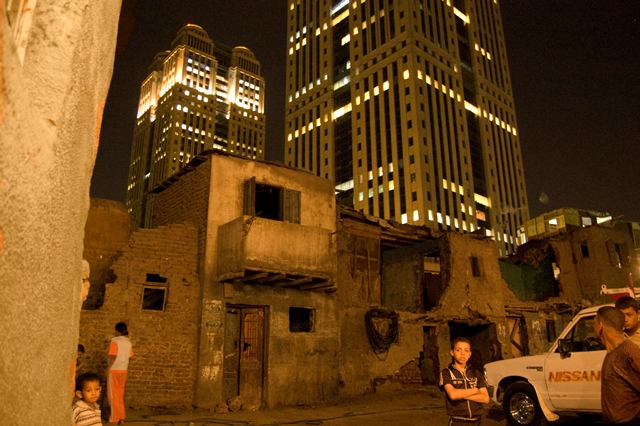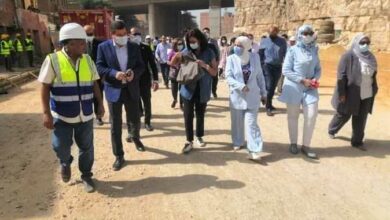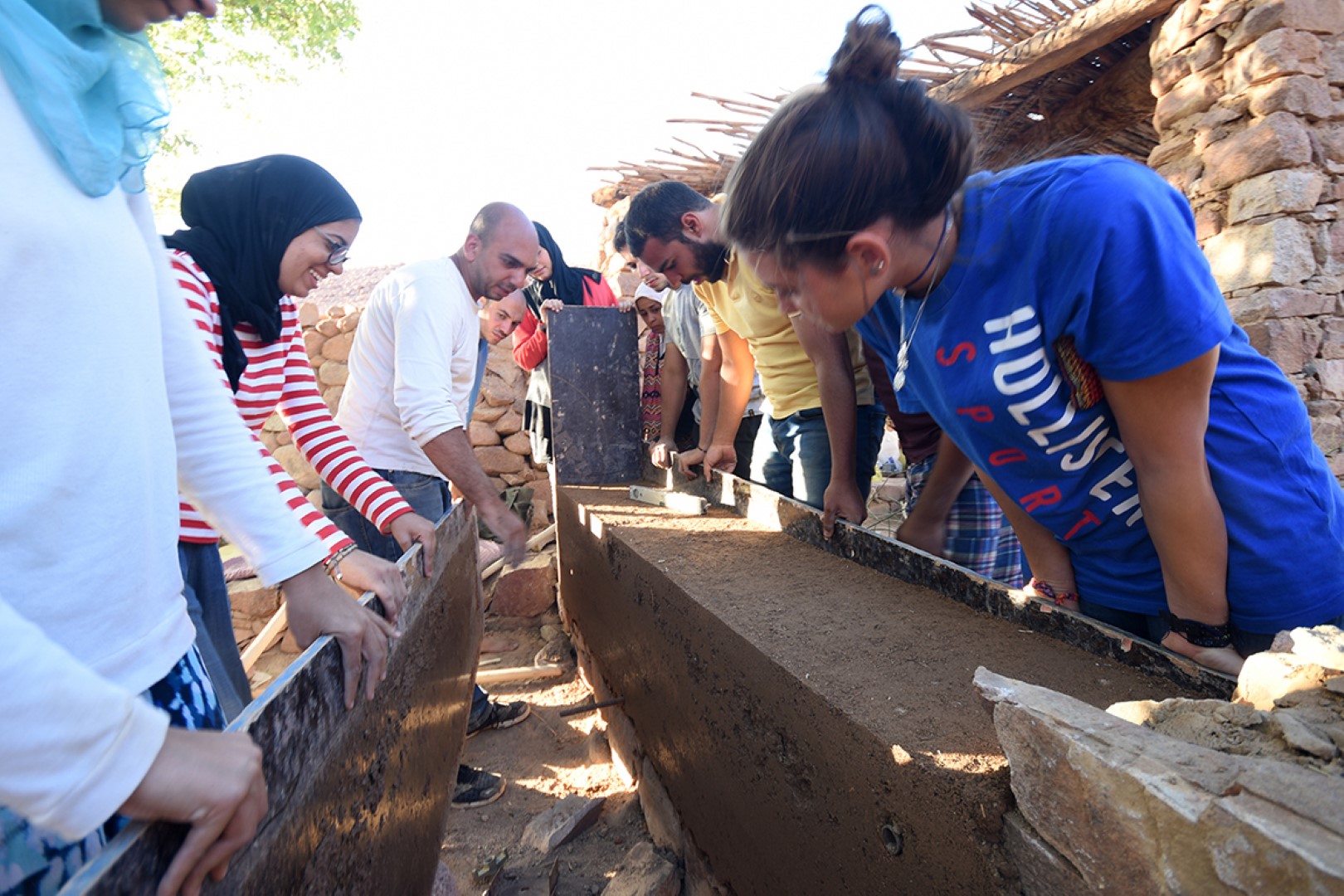
Amr Fathi is but the most recent fatality in Ramlet Bulaq, where slum dwellers have been struggling to keep their land from being confiscated by the state and telecommunications tycoon and billionaire Naguib Sawiris. Reportedly, Fathi was shot dead by a tourism police officer in the Nile City mall, part of the gleaming Nile City Towers complex, after demanding pay for his services as a temporary security guard that had been denied him for months.
According to slum residents, his body was taken outside the mall after he was shot dead. In an attempt to cover up, security forces then told them to quickly take him to an ambulance, claiming he was still alive. A scuffle erupted, and another resident, Anwar Ramadan Abdel Latif, was shot in his leg by the same officer that shot Fathi, residents said.
While Fathi’s body was still in the morgue, the Interior Ministry and the Fairmont Hotel, which is part of the Nile City Towers complex, were already preparing statements calling the residents of Ramlet Bulaq “thugs,” reminding us that the 32-year-old victim, famously known as Amr al-Bunni, has a long criminal record. From his side, the new interior minister, Ahmed Gamal al-Din, praised the security forces for their response to the “delinquents,” in his first official statement in office. As for the Fairmont Hotel, it is launching a campaign against “thuggery.”
Media also jumped on the bandwagon, likewise using the highly politicized label “baltagiyya” (thugs) to characterize the slum dwellers. Fathi’s death was marginally mentioned.
But inside the slum, the loss is deeply felt. Residents of Ramlet Bulaq said Bunni was a popular and well loved member of the community, whose young cousin had recently died in a fire which Nile Tower security refused to help put out. But their side of the story is not well publicized, and unlikely to be.
The attack of the slum on 2 August appears to be but one front in a blatant war of narratives.
The clashes
By the time I arrived, around 3:30 pm, cars set ablaze by residents angry over Fathi’s death were sending clouds of black smoke into the air. The lower windows on all sides of the north tower and the mall were not spared the resident’s fury either. Central Security Forces, deployed in large numbers, were firing tear gas at residents who lobbed rocks at them. The CSF chased protesters away to a long road behind the towers, along which there are several entrances to the slum. An armored vehicle had made its way there, the policeman on top of it reinforced by three others on the ground firing tear gas that now reached the slum. Protesters responded with glass bottles.
Somehow, a fragile peace allowed residents to plead with police who had by then formed a cordon at the entrance of the Fairmont, protecting the opulent hotel. Simultaneously, Ramlet Bulaq’s residents had formed a cordon protecting the entrance of the mall, obviously concerned about “thugs who want to take advantage of the situation”, as one resident put it, “giving us all a bad reputation.” The same man repeatedly called on “all who are not from Ramlet” to leave.
Tension was building up in the meantime, and rocks answered with tear gas and gunfire brought an end to the short-lived peace. The fire fighters, who had extinguished the burning cars, quickly left the scene.
Protesters were chased away deeply into the slum this time, a young man shot in his leg falling to the ground in the process. Officers dressed in white uniforms came closer as they were firing bullets into the slum, screaming that “anyone who walks out will be shot and taken.” For the next few hours, the street between the towers and the slum became the scene of the clashes, only to be halted by quiet during iftar, while residents broke their fast. Tear gas canisters and empty cartridges were scattered on the ground.
After iftar, it was dark, and had been quiet for about an hour and a half. Electricity was suddenly shut down, a precursor for the fighting that was about to re-erupt. When it did, the police heightened intensity, barrages of gunfire being heard more frequently now. No one was spared this time: Tear gas flew over the slum, covering it in its entirety and even reaching the Bulaq residencies behind it. Terrified children were crying and choking in the gas, an elderly woman fell to the ground.
In a bold move, a group of four women went out to negotiate the release of residents who had by then been arrested. Only seconds later, they ran back into the slum screaming, as their plea was answered with gunfire and tear gas; the officers in white uniforms had kept their promise.
Calm did not return before midnight.
“This needs to stop”
This episode of violence took place at the backdrop of an immense class disparity that has generated conflict for years. The Nile City Towers, jointly owned by Sawiris and the Saudi Shokhshobi family, are only a few meters away from the slum residents’ shacks. A previous investigation by Egypt Independent revealed that Sawiris has for years tried to acquire this valuable plot of land, and residents have refused to leave unless they get a fair compensation. The state seems to have taken Sawiris’ side, issuing an order on 20 June authorizing the police to evict the slum. Slum residents are employed by Sawiris informally to prevent anyone from reclaiming plots of land sold to Sawiris, or building an extra room.
This situation has taken a heavy toll on the slum dwellers in different forms. One is that residents have been unable to better their situation by developing the unsafe shacks they live in, often made of wood. The developers’ interest in the land has also led to reluctance to provide general utilities, for that would provide residents with an incentive to stay.
These conditions have contributed to the death of 5-year-old Ammar Mohamed Salah, Fathi’s cousin who was inside a wooden shack that caught fire after a gas-cylinder exploded on 27 June. Tower security initially refused to turn on the water, allowing the fire to rage until fire trucks arrived more than an hour later. Residents angrily attacked the towers with stones, only to be stopped by a police force that quickly arrived at the scene.
By contrast, only weeks earlier, in the second week of June, a gun battle that raged for three days in the slum prompted no police response, infuriating residents who endured birdshots, injuring dozens.
On 27 June, Mohamed Sayed died after he was shot in the stomach, reportedly by residents of a neighboring slum. Sayed Abdel Fattah, Mohamed’s father, had called the police several times in the build-up to the shooting. But there was no response this time.
Adding to this, Nile City security staff have used violence in what slum residents see as an attempt to force them out of their homes. Petrol bombs and shotguns have been used in attacks on slum residents, including one assault on an elderly resident by burly private security guards employed by Nile City.
The above incidents have only added fuel to the fire, further deteriorating the precarious relationship between Ramlet Bulaq residents and Nile City, the latter of which enjoys the protection of the police.
Bunni’s death is only the latest tragedy resulting from this explosive encounter between slum residents and wealthy developers who are after the land they live on. Material losses aside, this encounter is taking its toll exclusively on the poor, with three funeral processions on their side since June.
Mohamed Salah, father of the deceased Ammar, was tirelessly trying to stop the fighting on Thursday. While in the slum, he stopped residents from throwing rocks, knowing that “every stone is being answered with a salvo of tear gas.”
As tear gas canisters were flying over his head, he pleaded with those who were fighting back to take it outside the slum, for “we have children and elderly here.” The next day, on the phone, he said, “This needs to stop. My son died, and nothing changed. We are being taken under fire here, why isn’t anyone doing anything? My son is dead, and I want my voice to be heard.”




